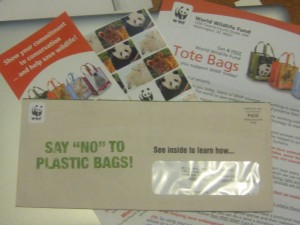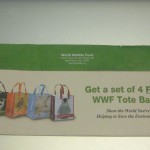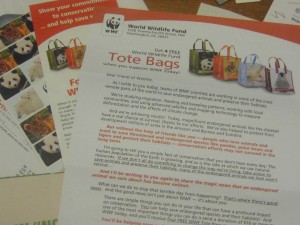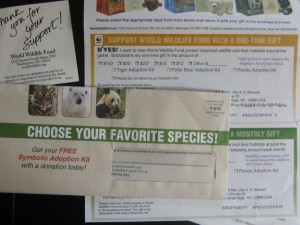I may have been a bit tough on World Wildlife Federation in my last diatribe. (Though it’s fascinating how many people search for “should we let the tiger go extinct?”) So instead of slamming their new direct mail deck, I’m going to assume there was a bit of slippage between the creative brief and the execution and suggest some ways they can tighten it up.

On the front of the OE (the most important part of the entire package by far) we have the teaser, “Say no to plastic bags! See inside to learn how….” There’s a WWF logo as a corner card but it could just as easily have been WTF since it’s a complete disconnect with the teaser. On the back we have…. Plastic bags! Four of them, your gift when you “Show the World You’re Helping to Save the Environment” (note the Needless Use of Title Case, a telltale sign that nobody is minding the store).
I can see the copywriter and designer brainstorming this concept… sort of like the songwriting team in Smash, sticking index cards on a board then standing back and regarding them with furrowed brow… while the account director mutters in the background like a hapless Greek chorus.

Copywriter: “Here’s an idea. Lots of people would like to stop using plastic bags but they have no idea how. Let’s show them!” Designer: “I love it! Plus, we’re giving away our own plastic bag as a premium. Since we know they’re into plastic bags, let’s send them four instead of one.” Account director: “Doesn’t that send a mixed message? And what does that have to do with saving wildlife anyway. Oh, never mind…”
Inside, it comes together somewhat. There’s a buckslip that explains when you get your totes you’ll “carry them everywhere and help reduce the use of plastic bags.” And if you’re looking for the connection between wildlife and plastic bags, you’ll find it near the bottom of the first page of the letter, sort of: “The average American uses 350 plastic bags each year. And they don’t just end up in landfills… they end up in oceans, too. Every year more than 100,000 whales, seals, turtles and birds die as a result of plastic bags.”

I turn the letter over, looking for details, and there are none. I know about the ghost sea of floating plastic in the Pacific off Hawaii, larger than Rhode Island. I imagine there are some ghastly Greenpeace-type tales to be told of birds getting their beaks caught in plastic bags, or animals choking on them. But the WWF copywriter does not bring it home with these details because they seem to have taken a vow about saying anything that may seem too harsh or negative. But wait a minute. Aren’t we raising funds for an environmental not-for-profit? Isn’t making people feel the pain what it’s all about?
I think the original assignment was “build a package around our free tote bags”. This is already a challenge because there is not an obvious and immediate connection between tote bags and wildlife. Somebody then decided to make it “educational” by helping people “learn” how to stop using disposable bags… that’s a rather condescending message to this audience which I expect is already environmentally savvy. And education in general (this package also has a “special insert” I am supposed to read called “10 Simple Things YOU Can Do to Help PROTECT the Earth”) is a deadly tactic for direct response. They aren’t going to stick around till the end of class, so you better ask them to reach for their wallet as soon as the tardy bell rings.
Really, the only way to make this package work is the simple logic of a/plastic bags kill animals b/here are some grisly ways c/you can stop the suffering by accepting our free gift. But the WWF’s creative team is into happy talk so they can’t do that. Time to bring in a new game warden.
